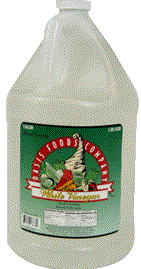Make a
Motorboat
This easy science project will be boatloads of fun for both you and your
children. Be sure to supervise your kids during this activity.
- Baking soda
- Several squares of toilet paper
- 1 clean 16-ounce plastic soda bottle with cap
1/4 cup vinegar
Bathtub or wading pool full of water
Pour 3 tablespoons baking soda onto a toilet paper square, and fold
square into a packet to hold the baking soda. Stuff the folded toilet paper
into the soda bottle. You can add 1 or 2 more squares to the bottle, but
don't overstuff. Hold bottle cap in one hand as you pour
1/4
cup vinegar into the bottle. Quickly put the cap on, and twist once. Put
bottle into the bathtub or pool. The reaction between the baking soda and
the vinegar should cause the bottle to "sail" across the water.
Vinegar and Baking Soda in a Jar
Experiment with Vinegar & Baking Soda: There are many
variations of this. I'll share this one:
- bottle
- balloon
- 1 Tablespoon baking soda
- 1 cup vinegar
- funnel (if need be, you can make one with a
rolled piece of paper)
-
Prepare balloon by stretching it over the bottle neck
a few times.
-
Fill balloon with a baking powder (use the funnel for
this, it'll be easier).
-
Fill jar with 1 cup of vinegar
-
Pull balloon over neck of bottle, but try not to let
the inside go into the bottle just yet.
-
Now, flip up the balloon, and quickly shake it into
the bottle, keeping the balloon on the neck at all times.
The balloon will begin to fill with the gass created by
the mixture.
Clean Dirty Pennies
*** For more ideas on how to clean Pennies with
Vinegar, and to find out what works best, check out:
Cleaning Pennies. ***
Shine up your pennies, and learn a thing or two about the chemical reaction
between vinegar and copper.
- 1/4 cup vinegar
- 1 teaspoon salt
- Clear, shallow bowl (not metal)
- 20 very dirty pennies
- Paper towels
- 2 rusty nails
- Add vinegar and salt to the bowl, and stir until the salt dissolves.
Using your fingers, dip one penny halfway into the mixture, and hold it
there for 10 seconds. What happened? The penny should become shiny. The
vinegar removes copper oxide, which is what causes pennies to become
dirty.|
- Next, put the remaining pennies into the vinegar mixture. Watch them
for a few seconds to see what happens. After 5 minutes, take 10 of the
pennies out of the mixture and leave the others in. Put the ones you took
out onto a paper towel to dry. Then remove the rest of the pennies, rinse
them under running water, and place on a paper towel to dry. Are there
differences in the two batches of pennies? You should observe that the
unrinsed pennies turned blue-green.
- Now put two rusty nails into the vinegar mixture. Make sure one is
completely covered in the mixture and the other is leaning against the
side of the bowl, only halfway into the mixture. After 10 minutes, look at
the nails and note the differences. One should be completely shiny, and
the one dipped halfway should be half shiny and half dull.
Make Magic Beans Using Vinegar
Fill a clear vase with water, and add a little food coloring. Then add
1/4 cup vinegar and 3 teaspoons baking soda.
Drop in dried beans, buttons, pasta, or rice, and see what they do in the
mixture. The small objects should rise to the top, then drop, then rise.
Egg
in Vinegar
- Jar
(or some type of container)
- 1
egg (raw or hard boiled. Raw can be more fun, but when you test it out
at the end of the project, do so in the sink.).
-
Vinegar (enough to fully immerse the egg)
Put an
egg still in its shell into a jar of vinegar, and check it the next day.
The eggshell, which is made of calcium, should become soft or disintegrate
completely. The egg should feel like rubber.
Try
bouncing it, lightly, in the sink. It may need another day or so for
this. The egg should feel rubbery and bounce. See Note #1.
Note #1: Different results have been found with this experiment. Some
people leave the egg for one day, some for two, some for
eight. Try using three eggs and see if you find whether there is any
difference or not.
Note #2: One source recommends leaving the egg out in the air,
after leaving it in the vinegar for a day. Try that, too.
Chicken Bone in Vinegar
- Save
a chicken bone from your next chicken dinner, get one from a friend who
eats chicken, or ask a local butcher.
- Put
it in a clear jar.
- Fill
the jar with vinegar, put the lid on.
- Llet
sit 1 week. Observe what happens to the bone.
The
bone should become flexible because the vinegar has caused the calcium,
which makes bones hard, to dissolve.
|
|
|
